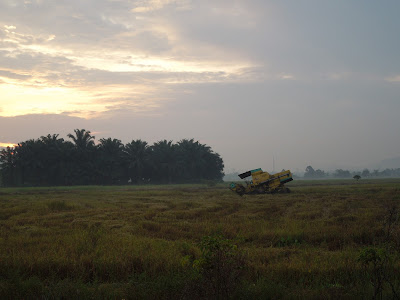The harvesting season had just begin
This year, it seem that the harvesting season in Permatang Pauh paddyfield begin in early August, and the season will last until early September - just ideal for paddy harvester chaser migrant such as herons and raptor - but I don't expect much Aquila's this year as it happen to be a late migrant.
muddy patch within paddy plot attract wader
After harvest, the remaining paddy straw will be burn down before the first plough - the gap within the burning process to the first plough is the best time to see 'in-land' wader, rail, crake and quail, the latter is the uncommon resident. After both burning and first plough, the paddy plot will turn out to be large mud field - during this time, some wader that use to feed in the coastal area such as golden plover, curlew sandpiper and in uncommon event small group of greenshank do visit this area when hightide.
Recently, huge flocks of Openbill had been seen in numerous location in west coast of Peninsular Malaysia - Most of the location where this bird had been seen share a same trait, most of them are paddyfield or wet plantation.
The so called new Openbill roost - this site - the mango tree island should be known for those familiar with Permatang Nibong - Kubang Semang - Permatang Pauh paddyfield complex
The first Openbill I saw after 2 years...
Although this paddyfield complex is the location where this species sighted in a number more than one, the number of openbill encounter during the dusk before this photo taken just 11 and I count about 16 in the morning. The 'new comer' bird use to be more curious and well aware on human presence - they took off in a range about 50m. The Openbill visiting this area in 2010/2011use to be more timid and approachable in distance about 15-20m.
The lazy flock - maybe these three stork is the last to left the roost
......





